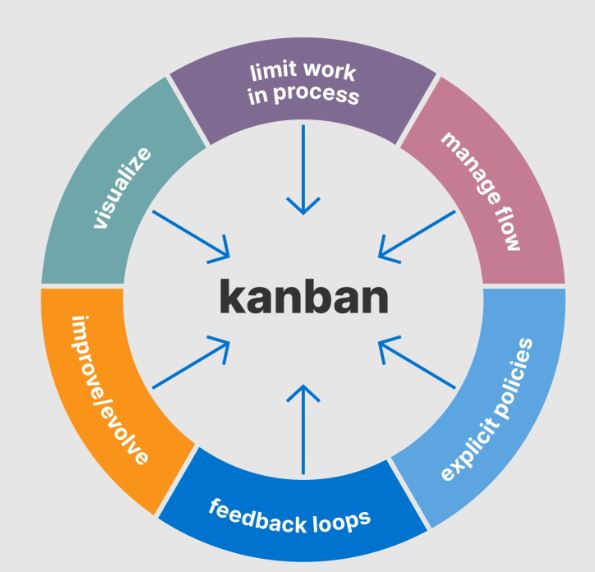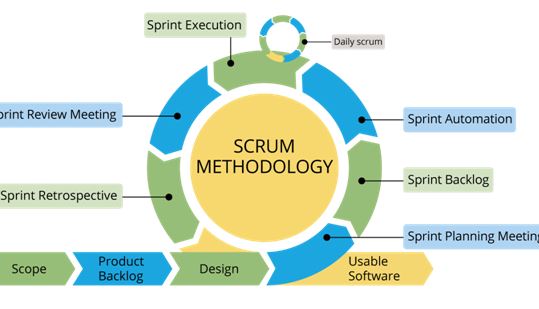
Agile Scrum Vs Kanban | Know the difference
Last updated on 27th Oct 2022, Artciles, Blog
- In this article you will learn:
- 1.What is Scrum?
- 2.What is Kanban?
- 3.Why Use Scrum?
- 4.Why use Kanban?
- 5.The Scrum process.
- 6.Kanban process.
- 7.Difference Between Scrum and Kanban.
- 8.Conclusion.
What is a Scrum?
Scrum is the agile process that helps to deliver a business value in shortest time. It is rapidly and repeatedly inspects the actual working software. It emphasizes on teamwork and an iterative progress of a software. Its goal is to deliver a new software every 2-4 weeks.
What is a Kanban?
Kanban is the visual system for managing a work. It visualizes both process and the actual work passing through that process. The main objective of an implementing a Kanban is to identify a potential bottlenecks in process and fix them. Kanban goal is that a work flow should proceed smoothly at optimal speed.
Why Use Scrum?
Scrum methodology can provide a project management for an every business, even across life in general. By using a Scrum, development team becomes a more Agile and discovering how to react a quickly and respond to sudden changes.Scrum addresses complexity in a work by making an information transparent. These help team to inspect and adapt based on a current conditions, instead of a predicted conditions. This helps a team members to address a common pitfalls and chaos resulting from a constantly changing requirements.
Why use Kanban?
Kanban methodology is a designed to meet a minimal resistance. So it allows continuous small incremental and an evolutionary changes to the current process. It also helps to be achieve improvements regarding throughput, lead time and quality.

The Scrum process:
The Scrum process are encourages team members to evaluate what is a working and what is not. Communication is the essential part of the scrum process. It is carried out a through meetings called an Events. Scrum Events include:
Daily Scrum:
The Daily Scrum is the small meeting that happens at a same place and time each day. At the end of an every meeting, the team reviews work that was completed on a earlier day and plans what work need to do in a next 24 hours. In a daily scrum team meeting members speak up about any problems which may become an obstacle to a project completion.
Sprint Planning Meeting:
Sprint refers to a time frame in which work must be completed, generally its a 30 days. In this sprint plan meeting, everyone should help to set a goals. In the end, at least one increment of a software should be produced.
Sprint Retrospective:
A Sprint Retrospective meeting take place after the Sprint ends. In this session everyone reflects on a Sprint process. A team-building process may be conduct in this phase. An essential goal of Sprint Retrospective is a continuous improvement.
Kanban process:
In a Kanban process, everything is be gradually improved whether it is a software development, Staffing, Marketing, Sales, Procurement, etc. The Kanban Method follows the certain set of principles for a managing and improving a flow of work.
Four principles of a Kanban Method are provided below:
1. Visualize Work:
By creating the visual model of work and workflow It helps to an observe a flow of work moving through Kanban system.
2. Limit work in a process:
It allows the team members to decrease a time taken by item to travel across Kanban system.
3. Focus on a flow:
By using a work-in-process limits and developing a team-driven policies can optimize Kanban system to improve smooth flow of work.
4. Continuous Improvement:
When Kanban system is in a place it acts as foundation for continuous improvement. It helps teams to measure an effectiveness by analyzing tracking flow quality lead times etc.

Difference Between the Scrum and Kanban:
| Scrum | Kanban |
|---|---|
| Scrum stresses on a planning. It starts with a sprint planning and ends up with sprint retrospective. There are more meetings held which help to assure that a team is aligned with a next steps, priorities, and learnings from previous sprints. | Kanban is an open to making a changes on the go. It means there is a less rigidity and things can be change frequently. |
| It recommends the collection of a time measurements made during sprints. | Kanban recommends graphs to get overview of a team’s progress over time. |
| Scrum no longer asks for the commitment from teams. Instead it is about a sprint goals and forecasts. | Kanban relies on a time-boxing and forecasts. |
| It stresses on a planning, and so estimation has a more important role in Scrum. | A Kanban has no mandatory requirements for an estimation. |
| Each individual has their role and responsibilities. | No set roles so flexibility in a term of individual responsibilities. |
| The iterations/Sprints are be fixed in a duration. This duration varies from a 2 weeks to 1 month. | Kanban is a not based on duration. This thing is a measured regarding Cycle times. |
| Teams are need to commit specific amount of work. | Commitment not be necessary it is optional for the teams. |
| In this method, a cross-functional teams are important as they can deal with the any disruption that may cause a bottleneck in a software development. | Having the specialized team is important. |
| It is not possible to add items to be ongoing iterations. | A New items can be easily add if an additional capacity is available. |
| A sprint backlog is an owned by only by a single team. | Multiple teams can be share a Kanban board. |
| Deliverables are be determined by a sprints, which a set of a work must be a completed and ready for a review. | Products and processes are be delivered continuously on needed basis. So testing and review a process goes on simultaneously. |
| Scrum software development method are focuses on a backlog. | Kanban method entirely a focuses on process dashboard. |
| Each team member has a specific role in Scrum master decide a timelines, product owner set goals and objectives, and team members conduct a development work. | There are no pre-defined roles for team. However, there may still be Project Manager; the team is be encouraged to collaborate and also works together. |
| Best for the projects with a changing priorities. | Ideal for teams with as stable priorities that unlikely to be change over time. |
| A Measures production using a velocity through sprints. | Measures production using a cycle time or the exact time it takes to complete a one full piece of project. |
| Scrum requires the complete shift from the traditional model to an Agile Scrum model that would be an implemented the project. | Kanban doesn’t allow the drastic changes in a project. |
| It is the ideal method for projects with a widely-varying priorities. | Best suitable for the teams with a stable priorities. |
| In Scrum, an entire team focuses on to collaborate and complete a task to provide a quality development work. | Teams work to can achieve goals and reduce the time to complete a entire process. Thus, reduction in time cycle is biggest indicators of a success here. |
| Scrum emphasis on its a schedules new items cannot be added to be ongoing iterations. | Kanban is much iterative by nature as it does not have specific timeframes. So that, a new items can be continually added whenever additional capacity is be available. |
| The total work is done in a batches/Sprints. | The entire project is performed on a movement of a single-threaded work item flows. |
| Scrum master acts as the problem solver. | Kanban encourages an every team member is a leader and sharing responsibility amongst them all. |
| A Scrum prescribes a time-boxed iterations. | Kanban focuses on a planning a various duration for an individual iteration. |
| Scrum helps firms to save a time and money. | Kanban method focus on a continuous improvement, productivity, and efficiency. |
| An Achieve stable and consistent communication of performance at all the levels. | A Team members are more likely to accomplish their goals much simpler because of a visual nature of Kanban boards. |
| Project are be coded and tested during a sprint review. | Team members are more likely to finish their goals much easier because of a visual nature of Kanban boards. |
| The total cost of a project is minimal which may lead to be quicker and cheaper result. | If a task is not be correctly estimated, the total project cost will never be can accurate. In such cases, a task can be spread over the several sprints. |
| This methodology needs an experienced team members only. So, If a team consists of people who are not expert, a project cannot be completed in a time. | No specific timeframes are allocated with every phase, so team members never get an idea how much time they can take in an every phase. |
| In this Agile Scrum method, it is simpler to deliver quality product at scheduled time. | It is designed for regular, steady output, major changes in a customer demand can make a Kanban fall. |
| The project plan will never be disturb even if team member leaves a team. | If any of team members are exit during development, it can be hurt a project development. |
| Daily meetings sometimes are frustrate team members. | An Outdated Kanban board can lead to an issues in a development process. |
| Large projects can simply divided into the easily manageable sprints. | Only works well with a small teams so not suitable for a large size team. |
Conclusion:
Scrum is the agile process that allows us to focus on a delivering the business value in a shortest time.Kanban is the visual system for a managing software development work.
Are you looking training with Right Jobs?
Contact Us- Hadoop Tutorial
- Hadoop Interview Questions and Answers
- How to Become a Hadoop Developer?
- Hadoop Architecture Tutorial
- What Are the Skills Needed to Learn Hadoop?
Related Articles
Popular Courses
- Hadoop Developer Training
11025 Learners - Apache Spark With Scala Training
12022 Learners - Apache Storm Training
11141 Learners
- What is Dimension Reduction? | Know the techniques
- Difference between Data Lake vs Data Warehouse: A Complete Guide For Beginners with Best Practices
- What is Dimension Reduction? | Know the techniques
- What does the Yield keyword do and How to use Yield in python ? [ OverView ]
- Agile Sprint Planning | Everything You Need to Know
